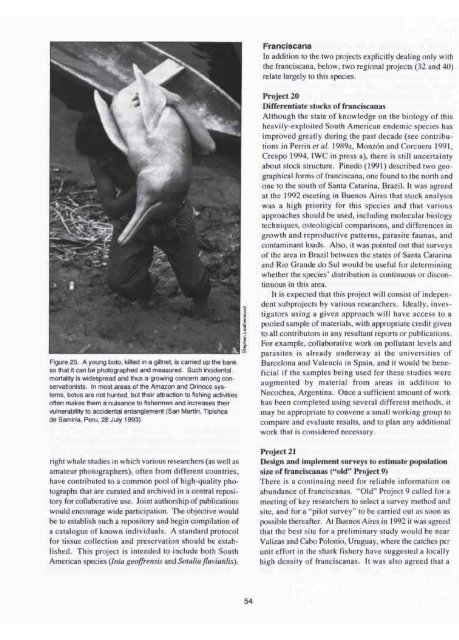Dolphins, Porpoises, and Whales - IUCN
Dolphins, Porpoises, and Whales - IUCN
Dolphins, Porpoises, and Whales - IUCN
You also want an ePaper? Increase the reach of your titles
YUMPU automatically turns print PDFs into web optimized ePapers that Google loves.
Figure 25. A young boto, killed in a gillnet, is carried up the bank<br />
so that it can be photographed <strong>and</strong> measured. Such incidental<br />
mortality is widespread <strong>and</strong> thus a growing concern among conservationists.<br />
In most areas of the Amazon <strong>and</strong> Orinoco systems,<br />
botos are not hunted, but their attraction to fishing activities<br />
often makes them a nuisance to fishermen <strong>and</strong> increases their<br />
vulnerability to accidental entanglement (San Martin, Tipishca<br />
de Samiria, Peru, 28 July 1993).<br />
right whale studies in which various researchers (as well as<br />
amateur photographers), often from different countries,<br />
have contributed to a common pool of high-quality photographs<br />
that are curated <strong>and</strong> archived in a central repository<br />
for collaborative use. Joint authorship of publications<br />
would encourage wide participation. The objective would<br />
be to establish such a repository <strong>and</strong> begin compilation of<br />
a catalogue of known individuals. A st<strong>and</strong>ard protocol<br />
for tissue collection <strong>and</strong> preservation should be established.<br />
This project is intended to include both South<br />
American species (Inia geoffrensis <strong>and</strong> Sotalia fluviatilis).<br />
54<br />
Franciscana<br />
In addition to the two projects explicitly dealing only with<br />
the franciscana, below, two regional projects (32 <strong>and</strong> 40)<br />
relate largely to this species.<br />
Project 20<br />
Differentiate stocks of franciscanas<br />
Although the state of knowledge on the biology of this<br />
heavily-exploited South American endemic species has<br />
improved greatly during the past decade (see contributions<br />
in Perrin et al. 1989a, Monzon <strong>and</strong> Corcuera 1991,<br />
Crespo 1994, IWC in press a), there is still uncertainty<br />
about stock structure. Pinedo (1991) described two geographical<br />
forms of franciscana, one found to the north <strong>and</strong><br />
one to the south of Santa Catarina, Brazil. It was agreed<br />
at the 1992 meeting in Buenos Aires that stock analysis<br />
was a high priority for this species <strong>and</strong> that various<br />
approaches should be used, including molecular biology<br />
techniques, osteological comparisons, <strong>and</strong> differences in<br />
growth <strong>and</strong> reproductive patterns, parasite faunas, <strong>and</strong><br />
contaminant loads. Also, it was pointed out that surveys<br />
of the area in Brazil between the states of Santa Catarina<br />
<strong>and</strong> Rio Gr<strong>and</strong>e do Sul would be useful for determining<br />
whether the species' distribution is continuous or discontinuous<br />
in this area.<br />
It is expected that this project will consist of independent<br />
subprojects by various researchers. Ideally, investigators<br />
using a given approach will have access to a<br />
pooled sample of materials, with appropriate credit given<br />
to all contributors in any resultant reports or publications.<br />
For example, collaborative work on pollutant levels <strong>and</strong><br />
parasites is already underway at the universities of<br />
Barcelona <strong>and</strong> Valencia in Spain, <strong>and</strong> it would be beneficial<br />
if the samples being used for these studies were<br />
augmented by material from areas in addition to<br />
Necochea, Argentina. Once a sufficient amount of work<br />
has been completed using several different methods, it<br />
may be appropriate to convene a small working group to<br />
compare <strong>and</strong> evaluate results, <strong>and</strong> to plan any additional<br />
work that is considered necessary.<br />
Project 21<br />
Design <strong>and</strong> implement surveys to estimate population<br />
size of franciscanas ("old" Project 9)<br />
There is a continuing need for reliable information on<br />
abundance of franciscanas. "Old" Project 9 called for a<br />
meeting of key researchers to select a survey method <strong>and</strong><br />
site, <strong>and</strong> for a "pilot survey" to be carried out as soon as<br />
possible thereafter. At Buenos Aires in 1992 it was agreed<br />
that the best site for a preliminary study would be near<br />
Valizas <strong>and</strong> Cabo Polonio, Uruguay, where the catches per<br />
unit effort in the shark fishery have suggested a locally<br />
high density of franciscanas. It was also agreed that a

















